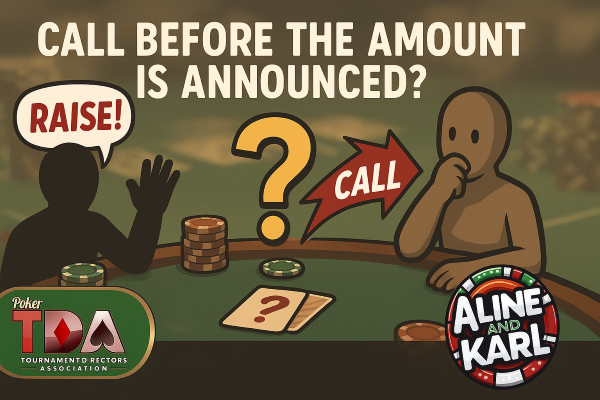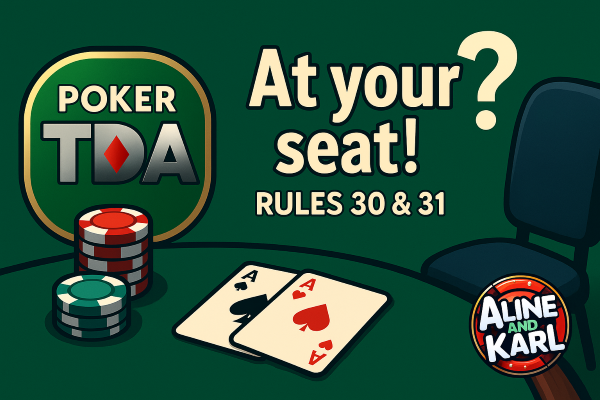🎯 Calling a Raise Before the Amount is Announced: How Should a Floor Rule?
A comprehensive analysis of a borderline case through the lens of the 2024 TDA Rules
🎬 The Situation: A Thorny Scenario
Picture this: you're managing a tournament and this situation unfolds at your table...📍 Sequence of actions at the table:
- 1. 🔸 Player A bets 10,000 chips
- 2. 🔸 Player B announces "raise" but does not declare an amount yet
- 3. 🔸 Player C immediately says "call" before B completes their action
❓ Critical Questions to Consider
This seemingly simple situation actually raises several fundamental questions:
- 🎯 Is C's "call" legally binding?
- ⚠️ Should this be treated as an out-of-turn (OOT) action?
- 🏛️ What options does the Floor have for ruling?
- 💰 Can a minimum or maximum amount be imposed?
- ⚖️ How do we balance fairness and rule enforcement?
📖 Regulatory Framework: Relevant TDA Rules
🏛️ Rule 1: Floor's Discretionary Power
"The best interest of the game and fairness are top priorities. Floor decisions are final."💡 Interpretation: The Floor has interpretive latitude to prioritize fairness and the spirit of the game over mechanical rule application.
🗣️ Rule 40-A: Verbal vs. Chip Action
"The first clear action—verbal or chips—defines the bet. If ambiguous, the Floor will rule under Rule 1."💡 Analysis: Player B said "raise" without announcing an amount, so no action is yet technically determined. C's "call" is premature.
⚡ Rule 42: Legal Raising Methods
"A raise must be made in one motion or by declaring the full amount before pushing chips."💡 Consequence: Until a specific amount is announced, there is no valid raise to follow or "call".
👤 Rule 2: Player Obligations
"Players must follow the action, act in turn, and make their intentions clear."💡 Verdict: Player C fails to meet their obligation to follow the action correctly.
⚖️ Ruling Options: 3 Possible Approaches
The Floor has several approaches to resolve this situation, each with advantages and disadvantages:
🟢 Option 1: The "Call" is Binding
🎯 Principle: The "call" commits Player C regardless of the final raise amount. ✅ Advantages:- Respects the spirit of Rules 1 and 40
- Holds players accountable for their declarations
- Simple to apply
- Potentially unfair if player was unaware of amount
- May create financially disadvantageous situations
🟡 Option 2: Educational Out-of-Turn
🎯 Principle: Consider that C acted too early and correct the action sequence. ✅ Advantages:- Educational and player-friendly approach
- Respects player intention
- Avoids excessive penalties
- May appear too lenient
- Risk of setting precedent
🔴 Option 3: Strict Application with Penalties
🎯 Principle: Rigid enforcement with financial and/or disciplinary consequences. ✅ Advantages:- Maintains table discipline
- Deters similar behavior
- Appropriate for repeat offenders
- May seem disproportionate
- Risk of player frustration
- Forced call at minimum legal raise
- Official warning to player
- Time penalty for repeated offenses
🗣️ TDA Community Perspectives
💬 Forum Feedback:
🔗 Official Discussion
- 🎙️ Vincenzo M : "The call should be binding if a raise has been declared."
🎯 Practical Recommendations
🎖️ For Floors:
- 1. Evaluate context: novice vs experienced player, apparent intent
- 2. Prioritize fairness according to Rule 1
- 3. Be consistent in decisions throughout the session
- 4. Clearly explain the ruling to all players
🎲 For Players:
- 1. Wait until amounts are clearly announced
- 2. Never act on incomplete declarations
- 3. Ask for clarification when in doubt
- 4. Respect action order at all times
✅ Conclusion: The Art of Fair Arbitration
🎯 This case perfectly illustrates the challenges of modern tournament direction: how to balance rule adherence with situational fairness?🔑 Key Takeaways:
For Players: Never call until a raise has been fully declared with an amount.
For Floors: Use Rule 1 judiciously to serve the best interests of the game and fairness.💡 Tournament direction isn't just mechanical rule application—it's an art requiring judgment, experience, and a sense of equity.




